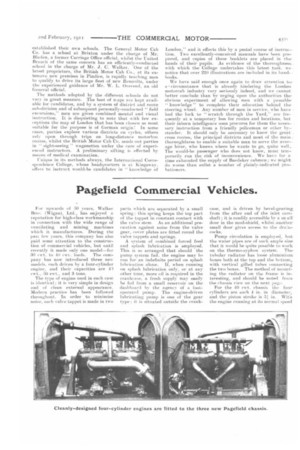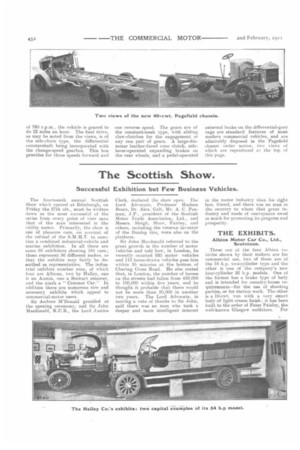Pagefield Commercial Vehicles.
Page 15

Page 16

If you've noticed an error in this article please click here to report it so we can fix it.
For upwards of 50 years. Walker Bran. (Wigan), Ltd., has enjoyed a reputation for high-class workmanship in connection with the wide range of ventilating and mining machines which it manufactures. During the pest few years, this company has also paid some attention to the construction of commercial vehicles, but until recently it minIc only one model—for
:10 cwt. to 40 ewt. loads. The company has now introduced three nev,models, each driven by a four-cylinder engine, and their capacities are 41 cwt., 50 cwt., and 3 tons.
The type of engine used in each case is identical ; it is very simple in design and of clean external appearance. Modern practice has been followed throughout. In order to minimize noise, each valve tappet is made in two parts which are separated by a small spring; this spring keeps the top part of the tappet in constant contact with the valve stem. As an additional precaution against noise from the valve gear, eover plates are fitted round the valve tappets and springs.
A system of combined forced feed and splash lubrication is employed. This is so arranged that should the pump system fail, tine engine may be run for an indefinite period on splash lubrication alone. If, when running on splash lubrication only, or at any other time, more oil is required in the crankcase, a fresh supply may easily be fed from a small reservoir on the dashboard hy the agency of a footoperated pump. The engine-driven lubricating pump is one of the gear type it is situated outside the crank
case, and is driven by bevel-gearing. from the after end of the inlet camshaft; it is readily accessible by a sn air door in the mud-shield, whilst another small door gives aceess to the draincocks.
Pump circulation is employed, hut: the water pipes are of mull ample size' that it would be quite possible to work on the thermo-syphon system. Thetubular radiator has loose abuninitutt boxes both at the top and the bottom5 with vertical gilled tubes connecting the two boxes. The method of mounting the radiator on the frame is interesting, and shook] be noted front the chassis view on the next pago.
For the 40 cwt, chassis the four cylinders are each 4 in. in diameter, and the piston stroke is 5), in. With the engine running at its normal speed of 780 r.p.m., the vehicle is geared to do 12 miles an hour. The final drive, as may be noted from the views, is of the aide-chain type, the differential countershaft being incorporated with the change-speed gearbox. This box provides for three speeds forward and one reverse speed. The gears are of the constant-mesh type, with sliding claw-clutches for the engagement at any one pair of gears. A large-diameter leather-faced cone clutch, sidelever-operated expanding brakes on the rear wheels, and a pedal-operated external brake on the differential-gear cage are standard features of most modern commercial vehicles, and are admirably disposed in the Pagefield chassis under notice, two views of which are reproduced at the top of this page.






















